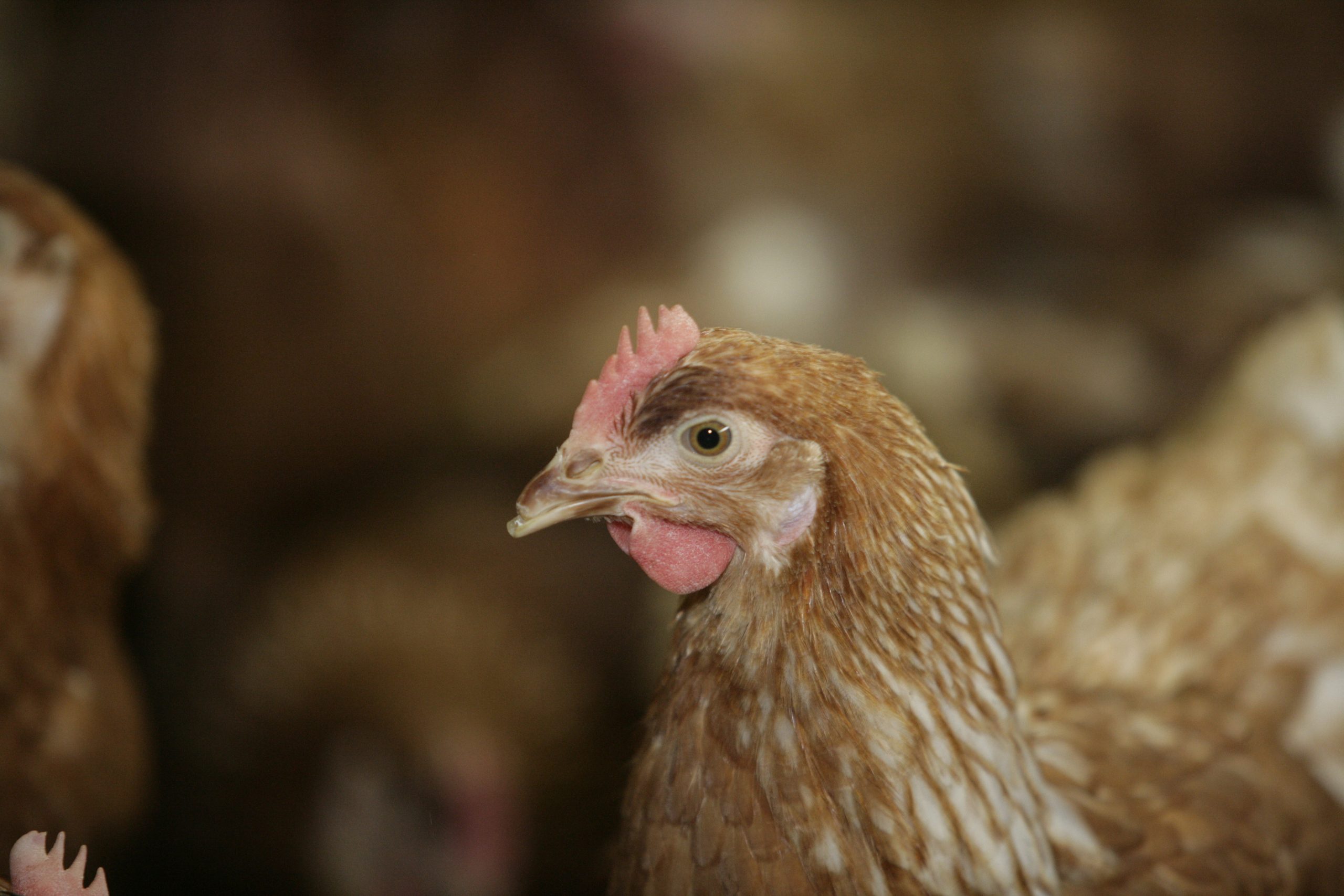Methionine supply status and effect on laying hens

High yielding laying hens need adequate amino acid supply. Not only for promoting health but also to improve welfare. Here we explain the effect of different methionine sources on feather quality and cannibalism in laying hen nutrition.
In egg production, substantial performance improvements have been achieved over the past years. In order to achieve current levels of performance of layers, adequate supply of nutrients and energy is crucial. Meeting the amino acid requirements is of utmost importance in this respect, especially when considering the protein and respective lysine, methionine (Met) and methionine+cysteine (Met+Cys) content of 7.5g, 0.53g, 0.26g, and 0.45g in a 65g egg, respectively. However, when compared to growing poultry, estimation of nutrient requirements and the respective dietary nutrient contents for laying hens is more difficult for various reasons. This particularly applies for determination of the methionine and cysteine requirement.
What is so special about methionine?
Methionine is an essential amino acid, as the body lacks the ability of de-novo synthesis and, therefore, it needs to be supplied with the feed. Cysteine can efficiently be synthesised from methionine. Thus, a cysteine shortage can readily be overcome by adequate methionine supply. Both, methionine and cysteine content in typical feed ingredients are low compared to the daily demand and so they are usually balanced with supplemental Met-sources. Methionine has various important functions in nutrition. The primary function is being a building block for protein synthesis. The body continuously synthesises proteins which can be deposited in the egg, in the body protein or in feather protein, or in functional proteins such as enzymes. From a nutritional point of view, one can distinguish between requirement for maintenance and for performance such as growth or egg production. The maintenance requirement is a function of live weight which still increases during early stages of the laying period. From approximately 20 weeks of age, the maintenance requirement for Met+Cys of the adult laying hen remains relatively constant. The sum of maintenance requirement and the demand for egg production basically define the total Met+Cys requirement. However, layers are still growing during the early part of the laying period and additional Met+Cys is required. Finally, Met and particularly Cys is deposited in feathers, which contain approximately 4% Met+Cys (3.4% Cys). First priority of the hen is to cover the maintenance requirement and to ensure reproduction, which is egg production (number of eggs). Metabolic supply for growth and feathers are of secondary importance and will be reduced in case of marginal or stronger deficiency in dietary Met+Cys consequently resulting first in reduced body and feather growth (and also egg size / weight) and only then in egg performance.
Figure 1 – Feeding trial in the Netherlands with Lohmann LSL hens for 40 weeks. Liqid MHA-FA and DL-Met were replaced in a 100:65 ratio.

Even a slight deficiency can make the difference
It can generally be said that feed formulations nowadays contain sufficient nutrient levels to allow high performance. Nevertheless, layer flocks with insufficient feathering as well as feather pecking, and even problems with cannibalism can be found. Such developments can be caused by a range of different things and careful evaluation of the conditions given is therefore needed. One of the important factors to check is the supply status of dietary Met+Cys. Under certain conditions it may well happen that the demand for high performances may not fully be covered. For instance, immunological reactions may require Met+Cys (and other nutrients and energy) reducing the available Met+Cys for other purposes. As outlined above, this first may result in retarded growth as well as in deterioration of the plumage or it might even lead to feather pecking. But also so called oxidative stress which deals with defence and elimination of free radicals in the metabolism can particularly increase the demand for cysteine, as cysteine is required for the synthesis of glutathione, a compound for eliminating radicals. Nutritionists indeed aim to satisfy the laying hens’ requirement but have to deal with variation of the raw material quality. Taking such uncertainties into account often safety margins are introduced in feed formulation. Today’s analytical capabilities allow keeping the safety margins as low as possible, which helps to optimise cost efficiency of feed. As outlined above, this can lead to a sub-obtimal supply of Met+Cys under unfavourable conditions. A further significant term in this equation is the nutritional valuation of methionine sources.
Figure 2 – Daily egg mass and feed conversion ratio of Lohmann LSL hens after 23 weeks of feeding graded levels of liquid MHA-FA or DL-Met-45; data obtained from Dänner and Bessei, 2003).

Methionine sources
DL-Methionine is an established Met-source in poultry nutrition. Recently, also L-Methionine has become commercially available. Both products are fully equivalent and can be used interchangeably. Although chemically not an amino acid, the hydroxy analogue of methionine is also commercially used as a methionine source (precursor) either as free acid (MHA-FA) or as calcium salt (MHA-Ca). Here the perception and implementation on the nutritional value can make a difference in successful laying hen nutrition. Meta-analysis studies suggest a biological equivalency of MHA products of 65% compared to DL-Methionine in poultry. In other words, 1000g of a commercial MHA product in feed can be replaced by 650g of L-Met without any detrimental effect on animal performance. Several trials replacing MHA products with DL-Met in a 100:65 ratio were conducted with laying hens. In each case performance of hens i.e. egg production, egg weight, egg mass, and feed conversion were unaffected. One example is a 40 week trial conducted in the Netherlands with Lohmann LSL hens where the performance curves were absolutely identical (Figure 1). In other studies replacement of MHA-FA with DL-Met was tested at three different Met+Cys levels in order to simulate different supply situations (Figure 2). The trial results illustrate that supplementation per se and increasing levels of supply improved performance. Between the corresponding liquid MHA-FA and DL-Met treatments, no significant difference was reported. However, in addition to the performance data, also causes for mortality were evaluated. These data together with data of a further experiment with similar design in which also performance between corresponding MHA and DL-Met treatments did not differ are shown in Figure 3.
Figure 3 – Overall mortality and mortality caused by cannibalism when feeding graded levels of liquid MHA-FA or DL-Met to Lohmann Brown hens after 24 weeks in test (left: week 22-46), and to Lohmann LSL hens after 23 weeks (right: week 22-45; data taken from Dänner and Bessei, 2003).

Decreased mortality
Basically, graded supplementation of methionine sources decreased mortality. However, the interesting observation in both of these trials is that, although there were no differences in performance, the mortality was lower in DL-Met fed layers when corresponding treatments are compared. Moreover, a substantial proportion of mortality was associated with cannibalism which was more pronounced in MHA-FA fed laying hens. In both trials, body weight gain as well as plumage quality improved with increasing supplementation of methionine sources, which clearly confirm the above described mechanism of partitioning of Met+Cys particularly under suboptimal nutritional conditions. So, particularly for the control diet but also at least for the first inclusion level not only performance, but also gain was lowest whereas mortality was high accompanied with reduced plumage quality and cannibalism. In the trials shown above DL-Met and liquid MHA-FA supplementations in corresponding treatments were added in a weight ratio of 65:100. If in feed production a higher bioequivalency would be assumed, the above data suggest that the problems with mortality in general and cannibalism in particular would increase as the corresponding MHA-FA supplementation levels would even be lower. In situations, where dietary Met+Cys levels are marginal or too low due to variation in raw materials or extra demand for Met+Cys for defending disease, pathogens or oxidative stress, an overestimation of the bio-equivalency of methionine hydroxy analogues may trigger these mechanisms and contribute to these problems.
Summary
In summary, methionine and cysteine are crucial amino acids which can easily turn into a performance limiting factor. Methionine is required as a building block and for various metabolic functions. Methionine is also a precursor for cysteine and thus both dietary gap of methionine and cysteine can be balanced by supplemental methionine sources. While DL-Met and L-Met are biologically equivalent, methionine hydroxy analogue products are less efficient. However, recommended bio-equivalency for the latter is 65% which means, each unit of hydroxy analogue can be replaced by 0.65 units of DL-Met. Overestimating the relative bioavailability of MHA-products can result in marginal deficiency of laying hens which consequently could result in higher feather pecking and cannibalism.











